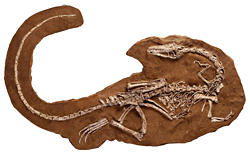DK Science: Death & Disease
Few dinosaurs reached old age. These creatures were constantly at risk from the environment and from other animals. Many dinosaur species are known only from fossils of juveniles that died before they could become adults. Some dinosaurs died in fights, some starved, some became diseased, and some died from injury. What is known about dinosaur illnesses is very limited. Only if a disease affected the bone is there any direct fossilized proof of what kind of illness it could have been. The study of such events is called palaeopathology.
In 1971, palaeontologists working in the Gobi Desert made a remarkable discovery – a Velociraptor skeleton wrapped round the skull of a Protoceratops, its hands grappling the head shield and its killer foot claw deep in the body cavity. The outcome of the fight is obvious – both perished, probably mortally wounded by each other, their remains engulfed by a sandstorm. This rare evidence of their last minutes has done much to inform scientists about their methods of fighting and defence
In 1947, the skeletons of a pack of hunting Coelophysis were found in Texas, USA. They all seem to have died during a drought. The best-preserved skeleton had some interesting remains in its stomach cavity – the bones of a young Coelophysis. The larger animals had resorted to cannibalism in the last, desperate hours of their lives.
The bones of big, heavy animals, particularly the largest dinosaurs, would always have been under a great deal of stress. Disease and injury often affect the bones of living animals and it would been the same with the dinosaurs. Sometimes, evidence has been found of bone infections in dinosaur fossils.
We do not know how long dinosaurs lived. The life expectancy of a large dinosaur, assuming that it survived the dramas of normal dinosaur life, would depend on whether it was cold- or warm-blooded, or something in between. If sauropods were cold-blooded, and are compared to modern reptiles, they may have lived for about 200 years. If warm-blooded, and compared to an elephant, they may only have lived up to 60 years.
To order this book direct from the publisher, visit DK's website.


